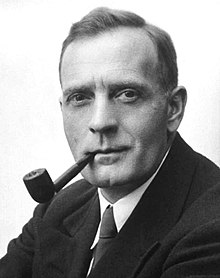
Back Edwin Hubble Afrikaans إدوين هابل Arabic ادوين هابل ARZ এডৱিন হাবল Assamese Edwin Hubble AST Edvin Habbl Azerbaijani ادوین هابل AZB Эдвін Паўэл Хабл Byelorussian Эдўін Габл BE-X-OLD Едуин Хъбъл Bulgarian
Edwin Hubble | |
|---|---|
 Portrait by Johan Hagemeyer, 1931 | |
| Born | Edwin Powell Hubble November 20, 1889 Marshfield, Missouri, U.S. |
| Died | September 28, 1953 (aged 63) San Marino, California, U.S. |
| Alma mater | |
| Known for | |
| Spouse |
Grace Burke Sr. (m. 1924) |
| Awards | See list
|
| Scientific career | |
| Fields | Astronomy |
| Institutions | |
| Military career | |
| Branch | United States Army |
| Years of service | 1918 |
| Rank | Major |
| Unit | 86th Division, 2nd Battalion, 343 Infantry Regiment |
| Battles/wars | World War I |
| Signature | |
| Part of a series on |
| Physical cosmology |
|---|
Edwin Powell Hubble (November 20, 1889 – September 28, 1953)[1] was an American astronomer. He played a crucial role in establishing the fields of extragalactic astronomy and observational cosmology.[2][3]
Hubble proved that many objects previously thought to be clouds of dust and gas and classified as "nebulae" were actually galaxies beyond the Milky Way.[4] He used the strong direct relationship between a classical Cepheid variable's luminosity and pulsation period[5][6] (discovered in 1908 by Henrietta Swan Leavitt[7]) for scaling galactic and extragalactic distances.[8][9]
Hubble provided evidence that the recessional velocity of a galaxy increases with its distance from Earth, a property now known as Hubble's law, although it had been proposed two years earlier by Georges Lemaître.[10] The Hubble law implies that the universe is expanding.[11] A decade before, the American astronomer Vesto Slipher had provided the first evidence that the light from many of these nebulae was strongly red-shifted, indicative of high recession velocities.[12][13]
Hubble's name is most widely recognized for the Hubble Space Telescope, which was named in his honor, with a model prominently displayed in his hometown of Marshfield, Missouri.
- ^ "Biography of Edwin Hubble (1889–1953)". NASA. Archived from the original on June 30, 2011. Retrieved June 21, 2011.
- ^ Redd, Nola Taylor. "Famous Astronomers | List of Great Scientists in Astronomy". SPACE.com. Perch. Retrieved April 6, 2018.
- ^ Reese, Riley. "Most Influential Astronomers of All Time". Futurism. Jerrick Ventures LLC. Retrieved April 6, 2018.
- ^ Hubble, Edwin (December 1926). "Extragalactic nebulae". Astrophysical Journal. 64 (64): 321–369. Bibcode:1926ApJ....64..321H. doi:10.1086/143018.
- ^ Udalski, A.; Soszynski, I.; Szymanski, M.; Kubiak, M.; Pietrzynski, G.; Wozniak, P.; Zebrun, K. (1999). "The Optical Gravitational Lensing Experiment. Cepheids in the Magellanic Clouds. IV. Catalog of Cepheids from the Large Magellanic Cloud". Acta Astronomica. 49: 223–317. arXiv:astro-ph/9908317. Bibcode:1999AcA....49..223U.
- ^ Soszynski, I.; Poleski, R.; Udalski, A.; Szymanski, M. K.; Kubiak, M.; Pietrzynski, G.; Wyrzykowski, L.; Szewczyk, O.; Ulaczyk, K. (2008). "The Optical Gravitational Lensing Experiment. The OGLE-III Catalog of Variable Stars. I. Classical Cepheids in the Large Magellanic Cloud". Acta Astronomica. 58: 163. arXiv:0808.2210. Bibcode:2008AcA....58..163S.
- ^ Leavitt, Henrietta S. (1908). "1777 variables in the Magellanic Clouds". Annals of Harvard College Observatory. 60: 87. Bibcode:1908AnHar..60...87L.
- ^ Freedman, Wendy L.; Madore, Barry F.; Gibson, Brad K.; Ferrarese, Laura; Kelson, Daniel D.; Sakai, Shoko; Mould, Jeremy R.; Kennicutt, Jr., Robert C.; Ford, Holland C.; Graham, John A.; Huchra, John P.; Hughes, Shaun M. G.; Illingworth, Garth D.; Macri, Lucas M.; Stetson, Peter B. (2001). "Final Results from the Hubble Space Telescope Key Project to Measure the Hubble Constant". The Astrophysical Journal. 553 (1): 47–72. arXiv:astro-ph/0012376. Bibcode:2001ApJ...553...47F. doi:10.1086/320638. S2CID 119097691.
- ^ Freedman, Wendy L.; Madore, Barry F. (2010). "The Hubble Constant". Annual Review of Astronomy and Astrophysics. 48: 673–710. arXiv:1004.1856. Bibcode:2010ARA&A..48..673F. doi:10.1146/annurev-astro-082708-101829. S2CID 119263173.
- ^ "Astronomer Sleuth Solves Mystery of Big Cosmos Discovery by Nola Taylor Redd, Space.com, November 14, 2011". Space.com. November 14, 2011.
- ^ Hubble, Edwin (1929). "A relation between distance and radial velocity among extra-galactic nebulae". PNAS. 15 (3): 168–173. Bibcode:1929PNAS...15..168H. doi:10.1073/pnas.15.3.168. PMC 522427. PMID 16577160.
- ^ Slipher, V.M. (1921). "Proc. Am. Philos. Soc". 56: 404–409.
{{cite journal}}: Cite journal requires|journal=(help) - ^ Segal, I.E. (December 1993). "Geometric derivation of the chronometric redshift". Proc. Natl. Acad. Sci. USA. 90 (23): 11114–11116. Bibcode:1993PNAS...9011114S. doi:10.1073/pnas.90.23.11114. PMC 47932. PMID 11607440.
© MMXXIII Rich X Search. We shall prevail. All rights reserved. Rich X Search